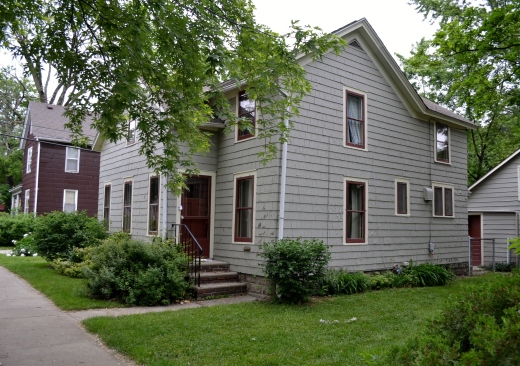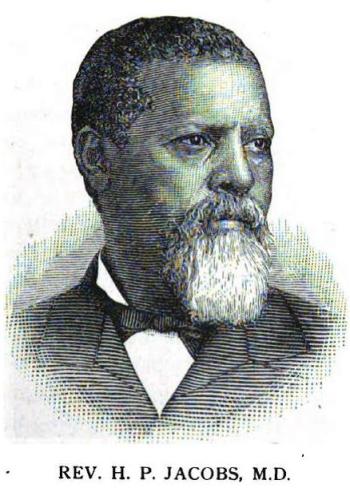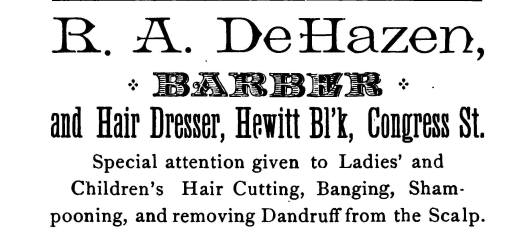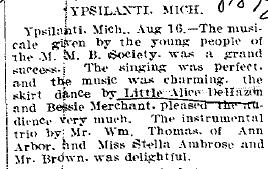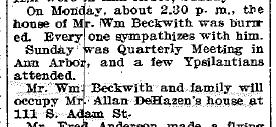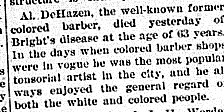The household with, perhaps, the most notable historic connections is at 111 South Adams, the house closest to Ypsilanti’s downtown along Michigan Avenue. For many years it was the home of the Robert Allen De Hazen and Anna Louise Jacobs family. It is also the household we know the most about.
Living here occasionally were also Anna’s sisters Julia and Mary, and the De Hazen’s only surviving child, Allie. After Anna died in 1895, Robert married Amanda Roper in 1897. In 1900, it was Robert and his young wife Amanda who were living at 111 South Adams.
Anna J Jacobs was born into slavery in St. Clair County, Alabama in 1851 or 1852 to Henry P Jacobs, born Samuel Hawkins, and his wife Louisa. According to a biographical sketch written in 1892 when he was still alive contained in Our Baptist ministers and schools, by A. W. Pegues. Henry P Jacobs, born July 8, 1825, learned to write while in slavery and forged ‘free papers’ for his wife and their three children and two of his brothers. They left Alabama on July 24th, 1856 for Canada, twice being stopped and their papers examined, where they arrived by way of the Detroit River on August 19th of that year.
On the 20th of October 1856, Henry P. Jacobs, who shed his slave name of Samuel Hawkins, was baptized in the Detroit River by the Reverend William Troy. Troy was minister to Canada’s refugees and author of Hair-breadth Escapes from Slavery to Freedom, who would, like Jacobs, return south after the war.
Up to 15,000 blacks had found refuge in Canada, many escaping from slavery, others escaping from racism in the years before the Civil War, including many who would later settle in Ypsilanti. A strong relationship between Michigan blacks and communities of color in Canada is evident in many of the stories and documents from this time. It is possible that the Jacobs family travelled through Ypsilanti on their way to Canada. It is there where we next find the family in 1859. Living with the black barber Norris Arnold, Jacobs finds work as a janitor at the Michigan Normal School, now Eastern Michigan University. This would prove to be a fortuitous decision in the lives of his daughters and granddaughter. Jacobs would enroll his daughters in the Music School attached to the college who would go on to become music teachers themselves.
Jacobs was ordained a Baptist preacher on September 18, 1858. While in Ypsilanti, Jacobs preached for the congregation of the Second Baptist Church which met at several locations in the town including the Presbyterian Church on Pearson Street, a private home on Babbit, the Adams Street School and in a building on Michigan Avenue between Normal and Ballard Streets. Said not to “stoop to the whims and petty prejudices in order to gain popularity”, Henry Jacobs would become one of the most prominent black Baptist ministers in the south in the years that followed and a somewhat divisive figure in the black Baptist community.
A January 11, 1865 Ypsilanti Free Democrat writes this about the Church then:
‘Rev. Mr. Jacobs, for a number of years a janitor at the Normal, is pastor. He is a good a thorough worker, and of good natural abilities. The Church have entered the house [the old Presbyterian Church] under very promising auspices. There is debt resting upon the purchase. They look to the benevolent in our city and elswhere to aid them. There is also a ladies aid society, whose object is to take care of the sick and bury the stranger dead. It meets once a week for moral improvement. Rev. H. Jacobs is president of the society.’
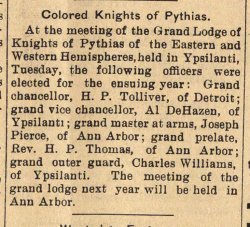
Sept. 8, 1897 Argus. Robert De Hazen was a leading member of local social and fraternal organizations. Courtesy Ann Arbor Public Library.
Sometime during or immediately after the Civil War, Henry Jacobs returned to the south where he helped to establish a seminary and school in Natchez, Mississippi to teach newly freed blacks to read and write. His connections to his children, Anna, Samuel (who died in Ypsilanti in the 1870s), Mary, Elizabeth and Julia, would remain strong. As an illustration: at least two of his daughters, Anna and Mary would be continue to use their maiden name Jacobs in their last names after marriage, relatively unusual for the time. Another factor keeping the family close was the early death of Anna’s mother, Louisa. As a result, Anna would take in her younger siblings.
Those daughters would join him in Mississippi where they would teach at Jacobs’ school, now Jackson State University. It is not known exactly when or how long they stayed in Mississippi before returning to Michigan. It is unlikely that Robert De Hazen joined his young wife in Natchez as no children are again born to this young couple until 1879. In 1873 De Hazen was living on the south side of Cross in Depot Town and working across the street at the Follett House, still extant.
Henry P. Jacobs would become one of the most important men in Mississippi in the Reconstruction years. In addition to helping found what would become Jackson State University, he was elected to the Constitutional Convention that drafted Mississippi’s post-war Constitution and then elected to the State’s senate three times in short order. He served as President of the Missionary Baptist Convention of Mississippi for seven years. Breaking with the Convention in later years he would, at the age of 65, get his doctorate in medicine at a college in Louisville, Kentucky.
We know he kept in contact with his friends and relatives in Ypsilanti; local newspapers print his inaugural speech to the Mississippi senate and in later years he would travel to Michigan to speak at the Emancipation Day Celebrations. Much of the organization of these events fell to the Colored Knight of Pythias, a black fraternal organization. As a junior Grand Master of his local lodge, Robert De Hazen also took a leading part in preparations for what was the grandest social and political occasion of the black calendar. According to his entry in Eric Foner’s Freedom’s Lawmakers, Jacobs died in Oklahoma sometime after 1898.
Here is the full text of 1892’s Our Baptist Ministers biography of Jacobs:
“Rev HP Jacobs was born a slave in St Clair County Alabama July 8 1825. His original name was Samuel Hawkins, he assumed the named Jacobs when he ran away from his home in Alabama to Canada. He learned to write while in slavery and wrote the free papers by which he his wife, three children, and brothers made their escape from the thralldom of slavery in the far south to the land of freedom Canada in 1856.
They left Alabama July 24 and reached Canada August 19. Twice on their journey they were taken up and lawyers examined their papers which were found to be all right apparently and after detaining the holders a half day they were permitted to go. The 2Oth of October of the same year Mr Jacobs was baptized in the Detroit river on the Canadian side by Rev William Troy now of Richmond Virginia. He was ordained to the work of the ministry September 18 1858. He has been a very successful minister of the gospel he does not stoop to whims and petty prejudices in order to gain popularity.
At the close of the civil war he went south and settled at Natchez Mississippi where for two years he taught a day and night school. Very few colored people at that time could read and write. Under what is known as the Reconstruction Act of Congress he was chosen a member of the Constitutional Convention of Mississippi he was a member of the convention which met at Jackson in the early days of reconstruction and organized by the Republican party in Mississippi. In recognition of his party services he was three times elected to the state legislature. He was one of the chief movers in the organization of the Missionary Baptist Convention of Mississippi of which he served as president seven years.
MD was regularly conferred upon Rev. Jacobs in the sixty fifth year of his age It seems that he did not countenance all of the ways of worship practiced by his people. He wanted to preach against all unnecessary customs and practices to do that he thought it necessary to be able to make a living independent of his ministerial work. He began the study of medicine and began to practice without ever going to college since none was convenient which he could attend. After twenty years practice he entered the medical college opened for colored people at Louisville, Ky. On the 3d of May 1890 he graduated with the degree MD.
As a physician he is very successful. Dr Jacobs is a man of great will power and determination. He believes it is never too late to do good and is constantly using his efforts for the good of his people.”
It is unknown when or how Robert DeHazen and Anna Jacobs met. By 1870 they are married and loving in Ypsilanti’s Second Ward with their young son Walter, who would die later that year. Robert would have been more than a decade older than Anna, she being only in her teens when they wed and began having children.
Robert was the most successful black barber in Ypsilanti, plying his trade for four decades. Barbering, including servicing white clients, was one of the few trades open to black people at the time and Robert would become successful own shops in several locations; first in Depot Town, later on Congress. In later years when segregation became more stringent, blacks would not cut white hair and the era of the black barber was over. This happened in De Hazen’s lifetime; the short notice in the Ypsilanti Commercial at his death reads, “In the days when colored barbers were in vogue he was the most popular tonsorial artist in the city and enjoyed the regard of both black and white.”
Alice Louise De Hazen was born to Ann and Robert on 18 July 1879. She would be there only child to survive into adulthood. The 1880 Census shows Robert and Anna living with their young daughter, Anna’s teenage sister Julia, and Elmer Fozz, a 19 year old black barber from Tennessee, possibly an apprentice of De Hazen, on River Street in Depot Town. Robert would also work at a barber shop in the Newell Block in Depot Town, also extant.
By the mid-1880s, Robert, known as ‘Al’ to most, was advertising in the local press and had moved shop to downtown Ypsilanti’s Hewitt Block on the northeast corner of Washington and Michigan. While working there Frederick Douglass would have spoken at least once, as would others including Harriet Beecher Stowe, in the now destroyed Hewitt Hall that sat above De Hazen’s barbershop. Depot Town, once home to many of Ypsilanti’s blacks, would become less hospitable as blacks moved and were moved south of Michigan Avenue.
At some point in the 1880s the family would also move to 111 South Adams Street, where they would remain until Al’s death. Two other children, Samuel (undoubtedly named after Anna recently deceased brother) and Robert, would be born to Robert and Anna. Samuel would not survive infancy while Robert, born in 1887, would die on 6 February 1891 when the family was living at 111 Adams home.
Their daughter Alice, known as Allie, would study music at the Normal School and under her mother who also taught music at the black school on Adams Street, still extant. In addition, Anna’s younger sister Mary would reside with them while she also attended the Music College at the Normal School. It is probable that, given the family’s standing and activities, a great many people stayed in this home. H.P. Jacobs visited his daughter on a number of occasions while they were living on Adams Street.
Two short biographical sketches written in 1895 of Allie and her aunt Mary highlight the role of Anna Jacobs-De Hazen, “a pianist of unusual ability,” and music in their lives. According to the sketch Allie entered the Normal College at only ten years old, “winning for her the reputation of being an exceptionally bright scholar and a good student.” Music was a part of Allies life “almost from infancy.”
She studied Mozart, Wagner, Mendelssohn and Hayden performing for “weddings, balls, receptions, and entertainments given by the aristocracy and wealth of Ypsilanti, Ann Arbor, Detroit and Wayne.” Allie won first prize (a mandolin) at the Washtenaw County fair at the age of 15. Written after the early death of her mother on 6 March 1895, the sketch says that Anna “bestowed upon her children a wealth of love and the results of her own education.” Said to have tastes that were “refined and artistic,”
Allie would go on to study mandolin and dance. She would marry Leonard Honesty, a young graduate of UM Medical School, and move with him to Washington, Pennsylvania where he practiced as a physician in the black community and she taught music. They had one son, Leonard Jr. She died sometime after 1940.
Mary, Anna’s younger sister who lived with the De Hazen’s while she studied music, also went south to Natchez to study and then to teach. While the connection to their father Henry must have been very strong, it is curious that the daughters of this famous Baptist minister would all become Episcopalians, confirmed into Ypsilanti’s St. Luke’s Church, also still extant.
After the death of Anna in 1895, Mary, Anna’s younger sister, married and moved to Adrian, Michigan where she was joined by Allie who attended school there. Robert remarried the much younger Amanda Roper (born in 1872 in Canada) in 1897. It is possible that Amanda was a music student of Anna Jacobs-De Hazen before she died. Robert died on November 12, 1901 of Bright’s disease. Both he and Anna are buried in Ypsilanti’s Highland Cemetery.
